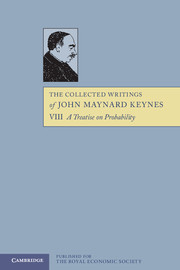Book contents
- Frontmatter
- Contents
- General Introduction
- Editorial Foreword by R. B. Braithwaite
- Editorial Note
- Preface to the First Edition
- I FUNDAMENTAL IDEAS
- II FUNDAMENTAL THEOREMS
- III INDUCTION AND ANALOGY
- IV SOME PHILOSOPHICAL APPLICATIONS OF PROBABILITY
- V THE FOUNDATIONS OF STATISTICAL INFERENCE
- 27 THE NATURE OF STATISTICAL INFERENCE
- 28 THE LAW OF GREAT NUMBERS
- 29 THE USE OF A PRIORI PROBABILITIES FOR THE PREDICTION OF STATISTICAL FREQUENCY—THE THEOREMS OF BERNOULLI, POISSON, AND TCHEBYCHEFF
- 30 THE MATHEMATICAL USE OF STATISTICAL FREQUENCIES FOR THE DETERMINATION OF PROBABILITY A POSTERIORI—THE METHODS OF LAPLACE
- 31 THE INVERSION OF BERNOULLI'S THEOREM
- 32 THE INDUCTIVE USE OF STATISTICAL FREQUENCIES FOR THE DETERMINATION OF PROBABILITY A POSTERIORI—THE METHODS OF LEXIS
- 33 OUTLINE OF A CONSTRUCTIVE THEORY
- Bibliography
- Index
27 - THE NATURE OF STATISTICAL INFERENCE
from V - THE FOUNDATIONS OF STATISTICAL INFERENCE
Published online by Cambridge University Press: 05 November 2012
- Frontmatter
- Contents
- General Introduction
- Editorial Foreword by R. B. Braithwaite
- Editorial Note
- Preface to the First Edition
- I FUNDAMENTAL IDEAS
- II FUNDAMENTAL THEOREMS
- III INDUCTION AND ANALOGY
- IV SOME PHILOSOPHICAL APPLICATIONS OF PROBABILITY
- V THE FOUNDATIONS OF STATISTICAL INFERENCE
- 27 THE NATURE OF STATISTICAL INFERENCE
- 28 THE LAW OF GREAT NUMBERS
- 29 THE USE OF A PRIORI PROBABILITIES FOR THE PREDICTION OF STATISTICAL FREQUENCY—THE THEOREMS OF BERNOULLI, POISSON, AND TCHEBYCHEFF
- 30 THE MATHEMATICAL USE OF STATISTICAL FREQUENCIES FOR THE DETERMINATION OF PROBABILITY A POSTERIORI—THE METHODS OF LAPLACE
- 31 THE INVERSION OF BERNOULLI'S THEOREM
- 32 THE INDUCTIVE USE OF STATISTICAL FREQUENCIES FOR THE DETERMINATION OF PROBABILITY A POSTERIORI—THE METHODS OF LEXIS
- 33 OUTLINE OF A CONSTRUCTIVE THEORY
- Bibliography
- Index
Summary
1. The theory of statistics, as it is now understood, can be divided into two parts which are for many purposes better kept distinct. The first function of the theory is purely descriptive. It devises numerical and diagrammatic methods by which certain salient characteristics of large groups of phenomena can be briefly described; and it provides formulae by the aid of which we can measure or summarise the variations in some particular character which we have observed over a long series of events or instances. The second function of the theory is inductive. It seeks to extend its description of certain characteristics of observed events to the corresponding characteristics of other events which have not been observed. This part of the subject may be called the theory of statistical inference; and it is this which is closely bound up with the theory of probability.
2. The union of these two distinct theories in a single science is natural. If, as is generally the case, the development of some inductive conclusion which shall go beyond the actually observed instances is our ultimate object, we naturally choose those modes of description, while we are engaged in our preliminary investigation, which are most capable of extension beyond the particular instances which they primarily describe. But this union is also the occasion of a great deal of confusion. The statistician, who is mainly interested in the technical methods of his science, is less concerned to discover the precise conditions in which a description can be legitimately extended by induction.
- Type
- Chapter
- Information
- The Collected Writings of John Maynard Keynes , pp. 359 - 363Publisher: Royal Economic SocietyPrint publication year: 1978



